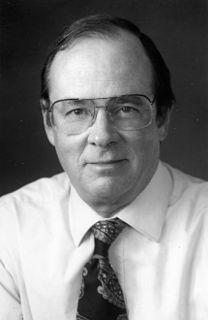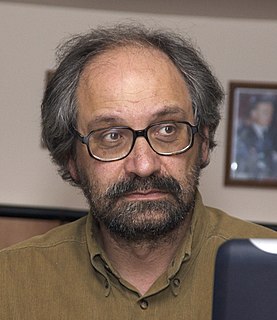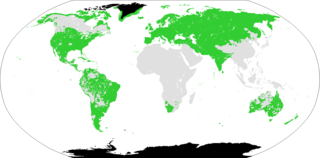Related Research Articles

Altaic is a sprachbund and controversial proposed language family that would include the Turkic, Mongolic and Tungusic language families and possibly also the Japonic and Koreanic languages. Speakers of these languages are currently scattered over most of Asia north of 35 °N and in some eastern parts of Europe, extending in longitude from Turkey to Japan. The group is named after the Altai mountain range in the center of Asia.
The Proto-Human language is the hypothetical direct genetic predecessor of all the world's spoken languages. It would not be ancestral to sign languages.
Glottochronology is the part of lexicostatistics which involves comparative linguistics and deals with the chronological relationship between languages.

Morris Swadesh was an American linguist who specialized in comparative and historical linguistics.
Lexicostatistics is a method of comparative linguistics that involves comparing the percentage of lexical cognates between languages to determine their relationship. Lexicostatistics is related to the comparative method but does not reconstruct a proto-language. It is to be distinguished from glottochronology, which attempts to use lexicostatistical methods to estimate the length of time since two or more languages diverged from a common earlier proto-language. This is merely one application of lexicostatistics, however; other applications of it may not share the assumption of a constant rate of change for basic lexical items.

The Santa Fe Institute (SFI) is an independent, nonprofit theoretical research institute located in Santa Fe, New Mexico, United States and dedicated to the multidisciplinary study of the fundamental principles of complex adaptive systems, including physical, computational, biological, and social systems. The institute is ranked 24th among the world's "Top Science and Technology Think Tanks" and 24th among the world's "Best Transdisciplinary Research Think Tanks" according to the 2020 edition of the Global Go To Think Tank Index Reports, published annually by the University of Pennsylvania.
Comparative linguistics, or comparative-historical linguistics is a branch of historical linguistics that is concerned with comparing languages to establish their historical relatedness.
The Swadesh list is a classic compilation of tentatively universal concepts for the purposes of lexicostatistics. Translations of the Swadesh list into a set of languages allow researchers to quantify the interrelatedness of those languages. The Swadesh list is named after linguist Morris Swadesh. It is used in lexicostatistics and glottochronology. Because there are several different lists, some authors also refer to "Swadesh lists".

Merritt Ruhlen was an American linguist who worked on the classification of languages and what this reveals about the origin and evolution of modern humans. Amongst other linguists, Ruhlen's work was recognized as standing outside the mainstream of comparative-historical linguistics. He was the principal advocate and defender of Joseph Greenberg's approach to language classification.

Dené–Caucasian is a proposed language family that includes widely-separated language groups spoken in the Northern Hemisphere: Sino-Tibetan languages, Yeniseian languages, Burushaski and North Caucasian languages in Asia; Na-Dené languages in North America; and the Vasconic languages from Europe.

Sergei Anatolyevich Starostin was a Russian historical linguist and philologist, perhaps best known for his reconstructions of hypothetical proto-languages, including his work on the controversial Altaic theory, the formulation of the Dené–Caucasian hypothesis, and the proposal of a Borean language of still earlier date. He was also the author of a widely respected reconstruction of Old Chinese.

In most classifications, the Eastern Sudanic languages are a group of nine families of languages that may constitute a branch of the Nilo-Saharan language family. Eastern Sudanic languages are spoken from southern Egypt to northern Tanzania.

Eurasiatic is a proposed language macrofamily that would include many language families historically spoken in northern, western, and southern Eurasia.
John D. Bengtson is an American historical and anthropological linguist. He is past president and currently vice-president of the Association for the Study of Language in Prehistory, and has served as editor of the journal Mother Tongue. Since 2001 he has been a member/researcher of Evolution of Human Languages, an international project on the linguistic prehistory of humanity coordinated by the Santa Fe Institute. His areas of specialization include Scandinavian languages and linguistics, Indo-European linguistics, Dené–Caucasian (Sino-Caucasian) languages, and paleolinguistics.

Borean is a hypothetical linguistic macrofamily that encompasses almost all language families worldwide except those native to sub-Saharan Africa, New Guinea, Australia, and the Andaman Islands. Its supporters propose that the various languages spoken in Eurasia and adjacent regions have a genealogical relationship, and ultimately descend from languages spoken during the Upper Paleolithic in the millennia following the Last Glacial Maximum. The name Borean is based on the Greek βορέας, and means "northern". This reflects the fact that the group is held to include most language families native to the northern hemisphere. Two distinct models of Borean exist: that of Harold C. Fleming and that of Sergei Starostin.
Paleolinguistics is a term used by some linguists for the study of the distant human past by linguistic means. For most historical linguists there is no separate field of paleolinguistics. Those who use the term are generally advocates of hypotheses not generally accepted by mainstream historical linguists, a group colloquially referred to as "long-rangers".

Georgiy Sergeevich "George" Starostin is a Russian linguist. He is the son of the late historical linguist Sergei Anatolyevich Starostin (1953–2005), and his work largely continues his father's. He is also known as a self-published music reviewer, author of the Only Solitaire Blog.

Alexander Militarev is a Russian scholar of Semitic, Berber, Canarian and Afroasiatic languages, comparative-historical linguistics, Jewish and Bible studies at the Russian State University for the Humanities.

Ilia Peiros is a Russian linguist who specializes in the historical linguistics of East Asia. Peiros is a well-known scholar in the Moscow School of Comparative Linguistics, known for its work on long-range comparative linguistics. Peiros is affiliated with the Santa Fe Institute in New Mexico, United States and was also a former faculty member at the University of Melbourne.
The Moscow School of Comparative Linguistics is a school of linguistics based in Moscow, Russia that is known for its work in long-range comparative linguistics. Formerly based at Moscow State University, it is currently centered at the RSUH Institute of Linguistics, and also the Institute of Linguistics of the Russian Academy of Sciences in Moscow, Russia.
References
- ↑ "Evolution of Human Languages: An international project on the linguistic prehistory of humanity". ehl.santafe.edu. Santa Fe Institute. Retrieved December 31, 2012.
- ↑ Velasquez-Manoff, Moises (July 20, 2007). "Linguists seek a time when we spoke as one". USA Today. Retrieved December 31, 2012.
- ↑ Mark Pagel, Quentin D. Atkinson, Andreea S. Calude, Andrew Meade. Ultraconserved words point to deep language ancestry across Eurasia. Proceedings of the National Academy of Sciences May 2013, 110 (21) 8471-8476; doi : 10.1073/pnas.1218726110
- ↑ "Evolution of Human Languages": current state of affairs (March 2014).
- ↑ Woodward, Richard B. "The Man Who Loved Languages: A Scholar with the Ability and Audacity to Rebuild the Tower of Babel Died a Year Ago, but His Controversial Project Lives on." The American Scholar 75, no. 4 (2006): 44-57. Accessed December 27, 2020.
- ↑ Evolution of Human Languages - The Participants.
- ↑ "Evolution of Human Languages - An Introduction" at Santafe.edu, retrieved 25 October 2007. New link, see here. Accessed Oct 27, 2009.
- ↑ The Tower of Babel project. at Starling.rinet.ru, retrieved 25 October 2007.
- ↑ Unified Transcription System (UTS) for the Global Lexicostatical Database.
- ↑ Starostin, George (ed.) 2011-2019. The Global Lexicostatistical Database . Moscow: Higher School of Economics, & Santa Fe: Santa Fe Institute. Accessed on 2020-12-26.
- ↑ Kassian, Alexei, George Starostin, Anna Dybo, Vasiliy Chernov. 2010. The Swadesh wordlist. An attempt at semantic specification. Journal of Language Relationship 4: 46–89. (PDF)
- ↑ Starostin, George. Preliminary lexicostatistics as a basis for language classification: A new approach. Journal of Language Relationship , No. 3 (2010). P. 79–116.